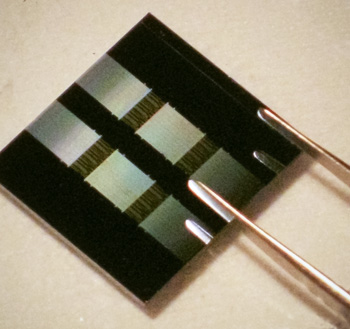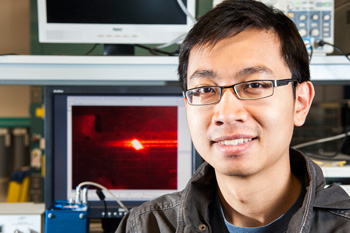UC San Diego Leads Researchers to Demonstrate First Single-Photon Generation from a Silicon Chip
By:
- Doug Ramsey
Published Date
By:
- Doug Ramsey
Share This:
Article Content

Researchers have now shown that quantum light sources can be fabricated using silicon, the most widely used material underpinning modern electronics. Shown here is a silicon photonic chip containing several dozen devices designed and fabricated by graduate students at the Electrical and Computer Engineering department at UC San Diego.
An international consortium of researchers has overcome an important barrier to the generation of single photons using a tiny, chip-scale device constructed from the most widely used material underpinning modern electronics: silicon. Their findings could hasten the advent of devices for quantum communication, ultra-low-power computing and other technologies now that all three basic components (sources, controllable circuits and detectors) of a quantum transceiver have been demonstrated using silicon photonics.
The researchers announced today that, for the first time, they generated so-called heralded single photons from a silicon chip. Heralded photons are the second in a pair of spontaneously-generated photons: when the first hits a detector and provides timing information, it ‘heralds’ the companion photon, which is then in a quantum mechanical single photon state. Led by the University of California, San Diego, other collaborators on the project include the National Institute of Standards and Technology (NIST) in Gaithersburg, Maryland and the Politecnico di Milano (Milan, Italy).
The 0.5 mm x 0.05 mm-sized device reported in this research was fabricated using CMOS-compatible processes on 200 mm silicon-on-insulator (SOI) wafers at an external collaborative research foundry, and operates at room temperature, generating quantum light in the near-1550 nanometer wavelength.
“That is in the infrared range and it is technologically important because those wavelengths are used in today’s optical fiber networks,” said Shayan Mookherjea, an associate professor of electrical and computer engineering at UC San Diego’s Jacobs School of Engineering. “Chip-scale single-photon sources could be used in quantum devices, networks and systems to bring about enormous improvements over their classical counterparts in terms of speed or security or computational complexity.”
Mookherjea and his colleagues foresee applications in cryptography, radiometry, imaging, telemetry, ultra-low-power communication and distributed quantum computing.
Results of the research will be presented in an invited talk by UC San Diego graduate student Junrong Ong at the Conference on Lasers and Electro-Optics (CLEO) on Thursday, May 10, 2012 at 3:30 pm (Session CTh3M). Mr. Ong is a third-year graduate student in Mookherjea’s Micro/Nano-Photonics group (http://mnp.ucsd.edu). This paper was selected as one of three finalists in the prestigious Maiman Student Paper Competition, which recognizes student innovation, research excellence and presentation skills in the areas of laser technology and electro-optics. The best-paper competition is endowed by HRL Laboratories, LLC, IEEE Photonics Society and APS Division of Laser Science.

Electrical and Computer Engineering graduate student Junrong Ong at UC San Diego is a finalist in the Maiman student paper competition. [Photo by John Hanacek/Calit2 UC San Diego.]
“Silicon is not an efficient light emitter, so creating a single-photon source using silicon was challenging,” said Ong. “Our demonstration of an on-chip, single-photon source is a first step towards achieving on a single silicon chip all the three main components needed for fully integrated quantum photonics.”
Indeed, the latest demonstration holds out the promise of integrated quantum transceiver chips on silicon. There are three basic types of components needed for quantum systems on a silicon chip: sources; circuits; and detectors. The latter two were recently demonstrated. Silicon waveguide circuits consisting of a network of controllable couplers and interferometers have demonstrated quantum interference and entanglement manipulation using off-chip light sources, and on-chip single photon counters have been formed using a superconducting layer deposited as a cladding of a silicon nanophotonic waveguide.
A journal article describing the latest results will be published in a forthcoming issue of the journal Applied Physics Letters, and a preprint is accessible at the online repository arXiv.org (arXiv:1201.2659v1 [quant-ph])
Single photon sources are expected to be key building blocks for future quantum-enabled technologies. “While a variety of single photon sources have been developed, they often involve non-standard fabrication processes or require cryogenic cooling,” said NIST’s Kartik Srinivasan, senior author on the journal article and project leader for nanophotonics at NIST’s Center for Nanoscale Science and Technology. “The devices studied by our team, in contrast, operate at room temperature and are built using mature fabrication techniques already applied in the manufacturing of computer chips.”
In this process, pump photons are split into pairs of photons at different wavelengths (called signal and idler photons) due to the optical nonlinearity present in the device. In bulk materials like macroscopic crystals and optical fibers, this nonlinearity is relatively weak, but in nanophotonic devices it can be significantly enhanced by a factor of up to a thousand, allowing for efficient photon pair generation within ultra-compact geometries.
Having created photon pairs in their devices, the team went further and demonstrated the process of heralded single-photon generation. This is important because photon pairs are generated by nonlinear optical pumping at random instants of time. Heralding is a process in which one photon of the pair is detected, thereby providing a time stamp with deterministic information that another (single) photon is available (“heralded”).

Dr. Shayan Mookherjea, Associate Professor of Electrical and Computer Engineering, in the Micro/Nano-Photonics Laboratory at UC San Diego. A comprehensive test suite, including optical, electrical and radio-frequency characterization equipment, is available for developing chip-scale devices for both classical and quantum device applications.
The device the researchers used was a novel silicon nanophotonic waveguide, consisting of a linear array of coupled micro-resonators. The waveguide has been developed by Professor Mookherjea’s research group in San Diego over the past decade.
To generate single photons, the team started with the closely related nonlinear optical process of photon pair generation, which has recently been demonstrated in silicon by a few groups using conventional waveguides and single-ring resonators. One of the key scientific highlights of this work is a slow-light enhancement of the pair generation rate per unit device length – the researchers have increased the effective nonlinear coefficient of this novel coupled-resonator waveguide to the extent that it is about one hundred thousand times higher than in commercial highly nonlinear fiber or photonic crystal fiber. Furthermore, the device was designed to allow resonant enhancement of all the optical fields involved (pump, signal, and idler), without fine tuning the optical wavelengths - a feat difficult to achieve in other systems. “Our novel device not only provides plug-and-play resonant enhancement of desired processes, but it also suppresses undesired processes by filtering out non-resonant pump noise effects,” explained Mookherjea.
The devices used in the project were measured by Mr. Ong and Dr. Marcelo Davanço in Dr. Kartik Srinivasan’s laboratory at NIST, using state-of-the-art telecommunications-band single photon counters, developed by Prof. Alberto Tosi and collaborators at the Politecnico di Milano. The researchers performed a photon correlation measurement, in which the heralded light was split into two separate paths and detected using single-photon counters. When working with single photons, it should not be possible to see heralded photons on both detectors simultaneously, which is called ‘anti-bunching’, as the researchers have confirmed.
Partial funding support was provided by the National Science Foundation through the CAREER, GOALI, and NIST Interaction in Basic and Applied Scientific Research programs, and by the UC San Diego Division of the California Institute for Telecommunications and Information Technology (Calit2). This collaboration was facilitated by Nick Bertone of Optoelectronic Components, Canada. Graduate student Junrong Ong is supported by a five-year fellowship from the Singaporean Agency for Science, Technology and Research.
Share This:
Stay in the Know
Keep up with all the latest from UC San Diego. Subscribe to the newsletter today.



